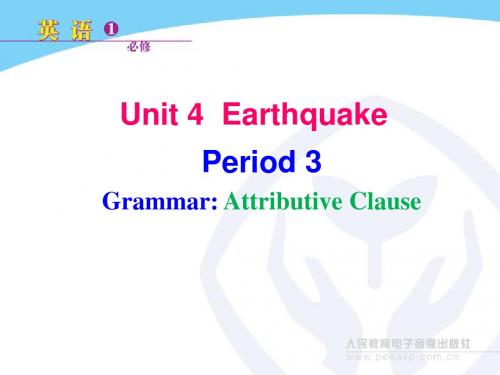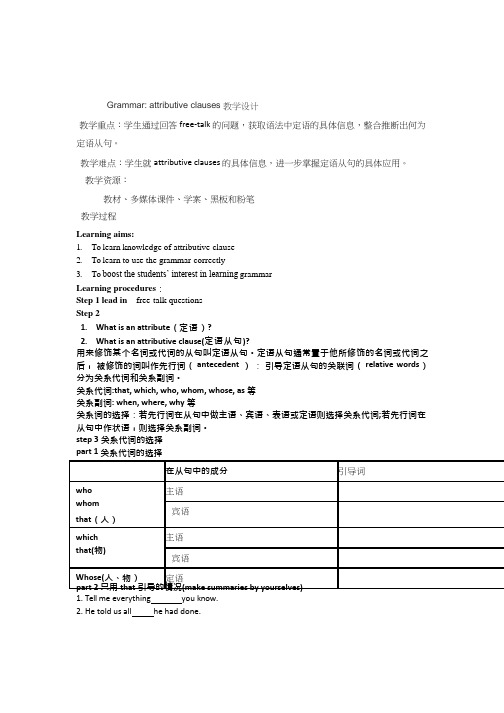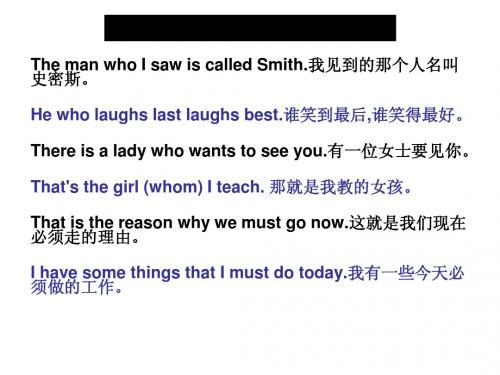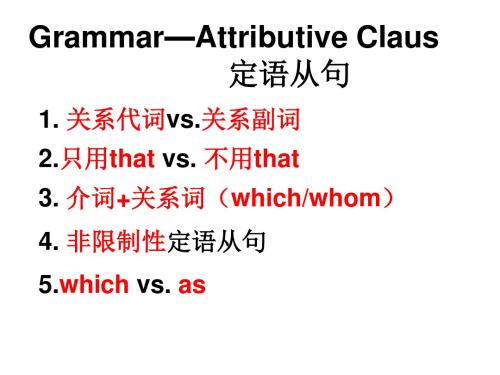attributive clause Grammar
- 格式:ppt
- 大小:2.44 MB
- 文档页数:17


Grammar: attributive clauses 教学设计教学重点:学生通过回答free-talk 的问题,获取语法中定语的具体信息,整合推断出何为定语从句。
教学难点:学生就attributive clauses 的具体信息,进一步掌握定语从句的具体应用。
教学资源:教材、多媒体课件、学案、黑板和粉笔教学过程Learning aims:1.To learn knowledge of attributive clause2.To learn to use the grammar correctly3.To boost the students’ interest in learning grammarLearning procedures:Step 1 lead in free-talk questionsStep 21.What is an attribute(定语)?2.What is an attributive clause(定语从句)?用来修饰某个名词或代词的从句叫定语从句。
定语从句通常置于他所修饰的名词或代词之后,被修饰的词叫作先行词(antecedent );引导定语从句的关联词(relative words)分为关系代词和关系副词。
关系代词:that, which, who, whom, whose, as 等关系副词: when, where, why 等关系词的选择:若先行词在从句中做主语、宾语、表语或定语则选择关系代词;若先行词在从句中作状语,则选择关系副词。
step 3 关系代词的选择part 1 关系代词的选择1.Tell me everything you know.2.He told us all he had done.当先行词为等词时3.I didn’t want all the glasses were on the table to fall off on to the floor.4.This is the only English -Chinese dictionary I have.当先行词被等修饰时5.This is the most beautiful city I have visited.6.This is the best has been used against pollution.先行词是形容词最高级或被形容词的最高级修饰时7.T his train is the last that will go to Suzhou.当先行词是序数词或它前面有序数词时8.The generals complained the Defense Department had not sent the extra man and equipmentthey needed.当先行词既是人又是物时9.Which is the coat you like best?Who is the man was talking to you?当主句是以who 或which 开头的特殊疑问句时10.China is no longer the country she was.先行词在定语从句做表语,而关系代词也在从句中作表语时,无论先行词是人还是物step 4 关系副词的选择(1)关系副词(先行词在从句中作状语时):时间状语when,地点状语where,原因状语why相应的关系副词可转化成相应的介词+which。

Grammar: The Attributive Clause【学习目标】To go on learning the Attributive Clause基础知识回顾:1. The teachers are present at our class are all experienced teachers.2. Our class is a big family consists of 12 girls and 50 boys.3. Yao Hui is the boy English study is very good in our class.4. The school we are studying is very famous.5. we all know, our school is 50 years old.关系词及其意义指代人who, whom, that, as指代事物which, that, as所属关系whose指地点where指时间when指原因why引导定语从句的关系代词的用法:1. that在从句中作主语或宾语,指人和物。
A plane is a machine that can fly.主语The noodles that I ate were delicious. 宾语Let’s ask the man that is reading the book over there.主语The girl that we saw yesterday is Jim’sister.宾语2. Which在从句中作主语或宾语,指物。
They planted the trees which didn’t need much water.主语The fish which we bought were not fresh. 宾语3. who whom 在从句中分别作主语和宾语,代指人(口语中who也可作宾语)。


Senior English for China Student’s Book 3Grammar, Module 5Attributive clauseThe teaching aims1) By reading sentences in reading and vocabulary, let students know about the definition of attributive clause2) To get familiar with attributive clauseThe important points1) Learn to use attributive clause. Especially pay attention to the attributive part.2) To grasp the conjunctions and learn to use them correctly.The difficult pointsTeach students to use the conjunctions,where, when, whose, who, which, that, whom, of which, etc.The teaching key pointsThe teacher should act as good director to make the students grasp the important points and the difficult points by more practiceThe teaching methodDiscovery Approach, Situational Language Teaching &The Communicative Approach The teaching toolsMultimedia-education systemProceduresStep1.Leading in:By asking students questions like: “Who is Confucius?”Students maybe answer “Confucius is the philosopher.” Then ask, “What about his influence?” “The greatest” Then combine two answers together to make a sentence of using attributive clause. The purpose is to ra ise Ss’ interest about the grammar.Step2 PresentationFirst, let Ss read the sentences on the screen and let them get familiar with attributive clause. When reading, underline the conjunction words and then discover how to use them. For example,Mozi was another teacher who was very influential.I know the girl who is good at English.The people that were here yesterday will return in a month.The newspaper that was on the steps belongs to our neighbor.The books (that) we bought are heavy.The town (that) this road leads to is five miles away.The suitcase which we purchased last week is very strong.The child who runs the fastest will receive a prize.The boy whom we visited is her nephew.The girl to whom you sold your skis lives in the next block.The woman whose house was sold will retire to the country.The boy (whom) / (that) we saw is her brother.The hat (which)/ (that) you are wearing is rather large.The boy to whom we sent the message was excited.The room to which you will be conducted has beautiful furniture.The room that you will be conducted to has beautiful furniture.By watching the two sentences the students will discover “who” is used to refer to a person as a subject.And Then use the same method to point out what the conjunction words refer to, Ss can improve the understanding of grammar, knowing how to use who, whom, whose, when, that, whose, of which and where.Resources1. Students may want to know more clearly about the usage of relative pronouns. A table can be used to explain as below:Relative pronouns used in attributive clauses2. To understand attributive clauses betterand use them correctly, students shouldbe able to identify which word is theantecedent and know what it functionsas in an attributive clause, so they canuse a proper relative pronoun tointroduce an attributive clause. Herearemore examples:The girl who/tha t is standing next to ourteacher is her daughter.The girl (whom/who/that) our teacher istalking with is her daughter.The girl whose mother is from Britain canspeak English very well.I can’t find the book which/that isborrowed from the library.I can’t find the book (which/that) you lentto me.Have you read the book whose author/theauthor of which is a high school student?I used to study in a classroom whose windows/the windows of which were allbroken.Sometimes the antecedent can be apronoun, such as someone/sb.,anyone/anybody, everyone/everybody,no one/nobody, sth., anything,everything, nothing, all, those, etc. Step3Practice& DiscussionDivide students into 4 groups to have a competition.First, use the conjunction words to fill in the blanks on the students’ book.Second, match the sentences to make them complete and fluent on the book. Third, organize the students to play a game by expanding the sentence using attributive clause like this:My friend is a girl.=>My best friend is a beautiful girl.=>My best friend whom I often talk about is a beautiful girl who has long hair.The factory is far from here.=>The big factory is far from here.=>The big factory where I worked is far from here ……..When the students do that, I give them a comment in time.At last, talk about your friend.Questions prepared for teacher to ask:who (is he/she?)Where (he/she lives?)When (did you know each other?)Which (things do you all like?)Whose (suggestion was often accepted?)Whose (advantages are more than the other?)Give proper praise to the winner.Step4SummaryIn this step,Ss will know what they have learned in this lesson ,and what they should master .This is a very important step for a successful lesson.Step5HomeworkWrite a short composition about your friend, using the attributive clauseThe design of blackboardFeed backThrough a lot of practice, I realize that the students can’t identify the components of sentence, which leads to misunderstanding of attributive clause and making mistakes. So I will make efforts to instruct in dividing the components of sentencevia the important partsof text in order to contribute to mastering the grammar.。

GrammarThe Attributive ClauseIdiom today God helps those who help themselves.StepⅠ. Revision1.What is the Attributive Clause?在复合句中,修饰名词或代词的从句叫定语从句。
2·被定语从句限定的词是______, 引导定语从句的词叫做________ 。
3.关系词有三大作用,即连接(连接定语从句和主句)、替代(替代前面先行词)、成分(在定语从句中要充当一定的句子成分)。
4.关系代词包括___ ___ ___ ___ ___ ___,使用口诀是:_____ ,_____ ;_____ ,_____。
关系副词包括___ ___ ___。
Exercise把下列简单句合并成定语从句1.The boy is my brother.He wears a red coat.2.I have a cat. The cat is called Kitty.3.The subject is English. I like it very much.4.Nobody wants the house. Its roof is broken.Don’t forget the things that once you owned(拥有). Treasure(珍惜)the things that you can’t get. Don‘t give up the things that belong to you(属于) and keep those lost things in memory.Please underline the attributive clauses and translate them._____________________________________________________________________ _关系代词that 和which 在很多情况下可以互换,但哪些情况只能用that ?A.All______can be done has been done.先行词(指物)本身是不定代词或先行词被不定代词修饰.B.Do you know the persons and the things I learned?先行词兼有指人和指物的名词C.This is the very book he is looking for.先行词(指物)被the very /only/ next/ last 等修饰D. This is the best TV is made in China.先行词(指物)被形容词最高级和序数词修饰E. Who you have ever seen can do it better ?当主句是which/who引导的特殊疑问句F.He is no longer the naughty boy he was inthe past. 先行词在句中作表语有哪些情况关系代词不用that ,而用which ?(1)关系代词置于介词之后,指物,作宾语The factory in ____ I once worked broke down(破产)last week.(2)先行词是整句话The boy didn’t come, made her angry.(3)非限制性定语从句,先行词是物Beijing, is the capital of China,is beautiful.1.(09山东卷)Whenever I met her ,___was fairly often,she greetedme with a sweet smile.A . WhoB . WhichC . WhenD . That 2.(09年全国卷2)My friend showed me around the town,___ wasvery kind of her.A . WhichB . ThatC . WhereD . It3 .My uncle has come back from abroad,______ I haven’t met for along time.A . whomB . whichC . thatD . whose1、在非限制性定语从句中,指事物用which,指人用who或whom,其中who 既可作主语也可作宾语而whom只能作宾语。